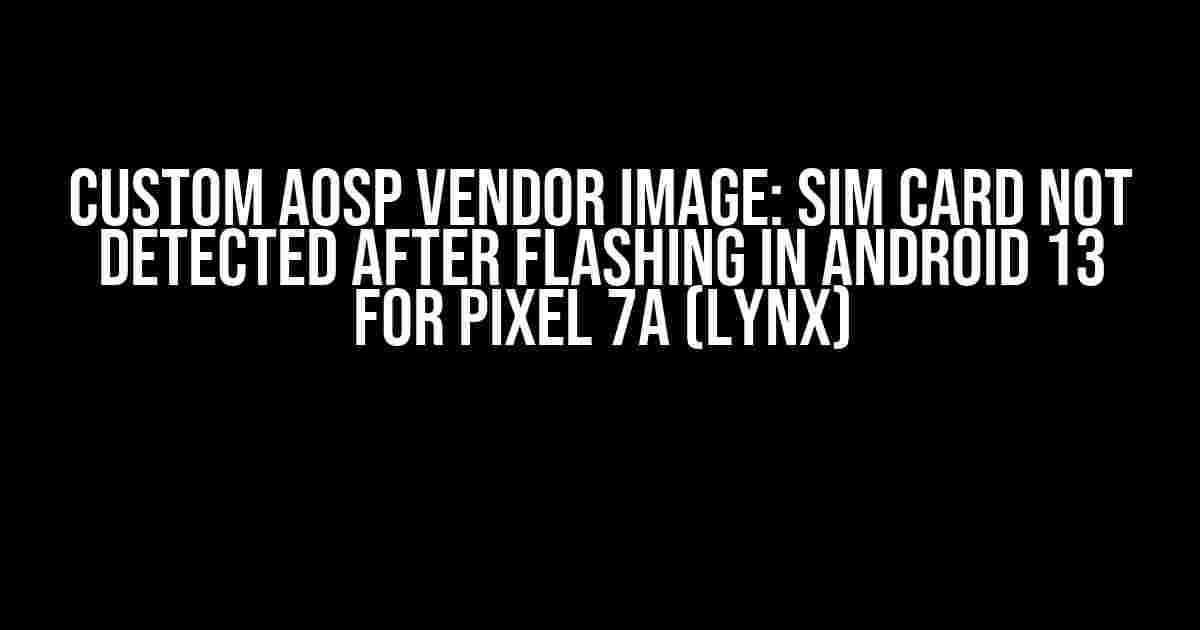Are you tired of dealing with the frustrating issue of your SIM card not being detected after flashing a custom AOSP vendor image on your Pixel 7a (lynx) running Android 13? You’re not alone! This tutorial will guide you through the steps to resolve this problem and get your SIM card working again.
What’s causing the issue?
Before we dive into the solution, let’s understand what’s causing the issue. When you flash a custom AOSP vendor image, it replaces the stock vendor image, which can lead to compatibility problems with certain hardware components, including the SIM card reader. This is because the custom vendor image might not include the necessary drivers or configurations for the SIM card reader to function properly.
The Fix: A Step-by-Step Guide
Don’t worry, we’ve got you covered! Follow these steps to fix the SIM card detection issue on your Pixel 7a (lynx) running Android 13 with a custom AOSP vendor image:
-
Download the necessary files
Download the following files:
vendor.imgfrom the official Google Pixel 7a (lynx) Android 13 vendor image packagevbmeta.imgfrom the official Google Pixel 7a (lynx) Android 13 vendor image packageflash_all.shscript (we’ll provide the contents below)
-
Extract the SIM card driver from the stock vendor image
Use the following command to extract the SIM card driver from the stock vendor image:
fastboot extract-vendor-partition vendor.img system/vendor/etc/firmware/MDM9690_1.mbn /sdcard/mdm9690.mbnThis will extract the
MDM9690_1.mbnfile, which contains the SIM card driver, to your device’s internal storage. -
Modify the
flash_all.shscriptCreate a new file called
flash_all.shand add the following content:#!/bin/sh fastboot update vendor.img fastboot update vbmeta.img fastbootflash-partition vendor-boot /sdcard/mdm9690.mbnThis script will update the vendor image and vbmeta image, and then flash the extracted SIM card driver to the vendor-boot partition.
-
Flash the modified vendor image and SIM card driver
Run the following command to execute the
flash_all.shscript:sh flash_all.shThis will flash the modified vendor image and SIM card driver to your device.
-
Reboot your device
Reboot your device to apply the changes.
-
Verify SIM card detection
Once your device boots up, check if your SIM card is detected by going to
Settings>SIM cards & mobile networks. If your SIM card is not detected, try restarting your device again.
Troubleshooting Tips
If you encounter any issues during the process, try the following troubleshooting tips:
-
Make sure you’ve downloaded the correct vendor image package for your device
-
Verify that you’ve extracted the SIM card driver correctly
-
Check that you’ve modified the
flash_all.shscript correctly -
Try flashing the vendor image and SIM card driver separately to isolate the issue
-
Perform a factory reset after flashing the modified vendor image and SIM card driver
Conclusion
That’s it! By following this tutorial, you should be able to resolve the SIM card detection issue on your Pixel 7a (lynx) running Android 13 with a custom AOSP vendor image. Remember to be patient and careful when working with your device’s firmware, and don’t hesitate to seek help if you encounter any issues.
| Device | Android Version | Vendor Image |
|---|---|---|
| Pixel 7a (lynx) | Android 13 | Custom AOSP |
We hope this tutorial has been helpful in resolving the SIM card detection issue on your device. If you have any further questions or concerns, feel free to ask in the comments below!
FAQs
Frequently Asked Questions:
-
Will this fix work on other Android devices?
This fix is specifically designed for the Pixel 7a (lynx) running Android 13 with a custom AOSP vendor image. However, the general principles may be applicable to other devices with similar issues.
-
Is it safe to flash a custom vendor image?
Flashing a custom vendor image can potentially brick your device or cause other issues. Make sure you understand the risks and take necessary precautions before proceeding.
-
What if I’m not comfortable with command-line interfaces?
Don’t worry! You can use a GUI-based tool like Fastboot GUI to flash the vendor image and SIM card driver.
Happy flashing!
Frequently Asked Question
Are you stuck with a custom AOSP vendor image on your Pixel 7a (lynx) running Android 13, only to find that your SIM card is not detected after flashing? Worry not, friend! We’ve got you covered with these frequently asked questions and answers.
Q1: Why is my SIM card not detected after flashing the custom AOSP vendor image on my Pixel 7a?
A1: This might be due to the fact that the custom vendor image doesn’t include the necessary configuration files for your SIM card. You’ll need to manually add the config files to the vendor image or use a different vendor image that supports your SIM card.
Q2: How do I add the necessary configuration files to the custom AOSP vendor image?
A2: You’ll need to extract the config files from a working vendor image or download them from the device’s manufacturer website. Then, you can add them to the custom vendor image using a tool like `vendor_image_patcher`. Make sure to follow proper instructions to avoid bricking your device!
Q3: Can I use a different vendor image that supports my SIM card?
A3: Yes, you can! Search for a custom vendor image that is specifically designed for your Pixel 7a (lynx) and Android 13. Make sure to read reviews and instructions carefully before flashing the new vendor image to ensure compatibility and avoid any potential issues.
Q4: Will I lose my data if I reflash the vendor image?
A4: Reflashing the vendor image will not affect your device’s internal storage or data. However, it’s always a good idea to backup your important data and files before attempting any modification to your device’s firmware.
Q5: What if I’m not comfortable with modifying my device’s firmware?
A5: If you’re not comfortable with modifying your device’s firmware, it’s highly recommended to seek guidance from a professional or an experienced Android developer. You can also consider waiting for an official update from Google or the device manufacturer that resolves the SIM card detection issue.


